Pam Hawley Marlin June 2019
Clark Thomas Richardson was an early pioneer of Garnett, Anderson County, Kansas. Arriving in Garnett in 1873 with his grandparents, Clark Pratt Richardson and Permelia Richardson, Clark Thomas grew up in Garnett and became one of the town's more prominent citizens. Clark Thomas began his career as a teacher in Kansas and Colorado from 1874-1883, and then served as Anderson County attorney in the late 1880's and 1890's. At the turn of the century, his career expanded to owner and editor of the Garnett Journal and the Garnett Evening Review. As teacher, attorney, editor, and publisher, Clark Thomas succeeded in becoming well known in each profession. My 3rd great-grandmother, Adelaide Amanda Hawley, was Clark Thomas Richardson's aunt.
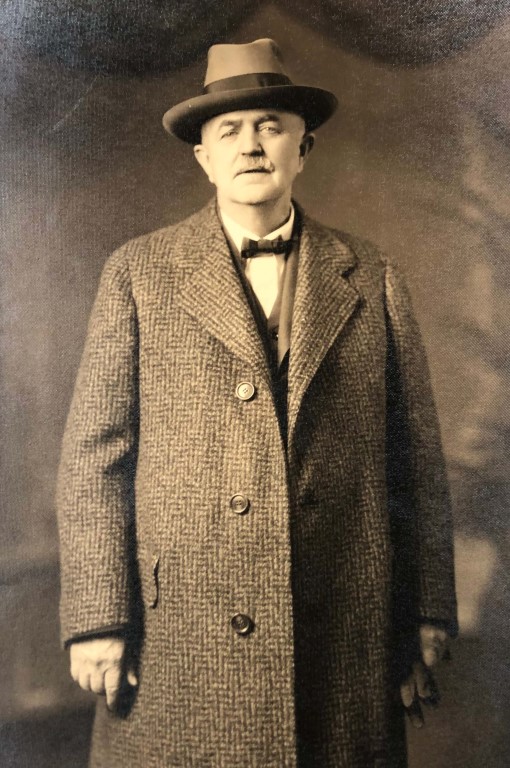 Clark Thomas Richardson. Anderson County
Historical Museum.
Clark Thomas Richardson. Anderson County
Historical Museum.
Research into Clark Thomas Richardson's early childhood was full of inconsistencies - census records listed his birth as both in Illinois and Minnesota, and additional records revealed he was raised by his grandparents, not his parents. It was discovered that the death of Clark Thomas' mother, Sarah, was the event that altered his childhood path.
Clark Thomas' mother, Sarah Richardson, was born near Panama, Chautauqua County, New York, to Clark Pratt Richardson and Betsey Rice. After Sarah's mom, Betsey, died in New York, Clark Pratt relocated his young children, including Sarah, to Riley, McHenry County, Illinois. It was in McHenry County that Sarah Richardson grew up. At the age of nineteen, she met a young man named Edy Mulcahie and they married in 1854.
After Edy and Sarah married, Edy bought land in Goodhue County, Minnesota, and he and Sarah relocated there in 1857. Their first child, a daughter named Mary, was born in Riley, Illinois in 1855, their second child, Clark Thomas, was born in Goodhue, Minnesota, in 1858, and their third child, Byron George, was born in Minnesota in 1860.
After the birth of her last child, Byron George, Sarah became seriously ill with consumption. On October 4, 1862, she died, leaving three small children to be raised by family members.
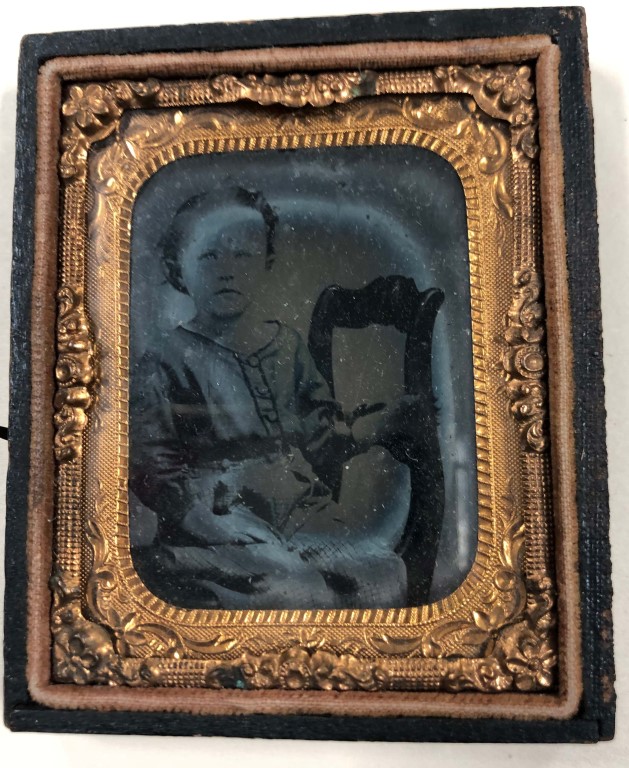 Clark Thomas Richardson, 4 years old. Anderson County
Historical Museum.
Clark Thomas Richardson, 4 years old. Anderson County
Historical Museum.
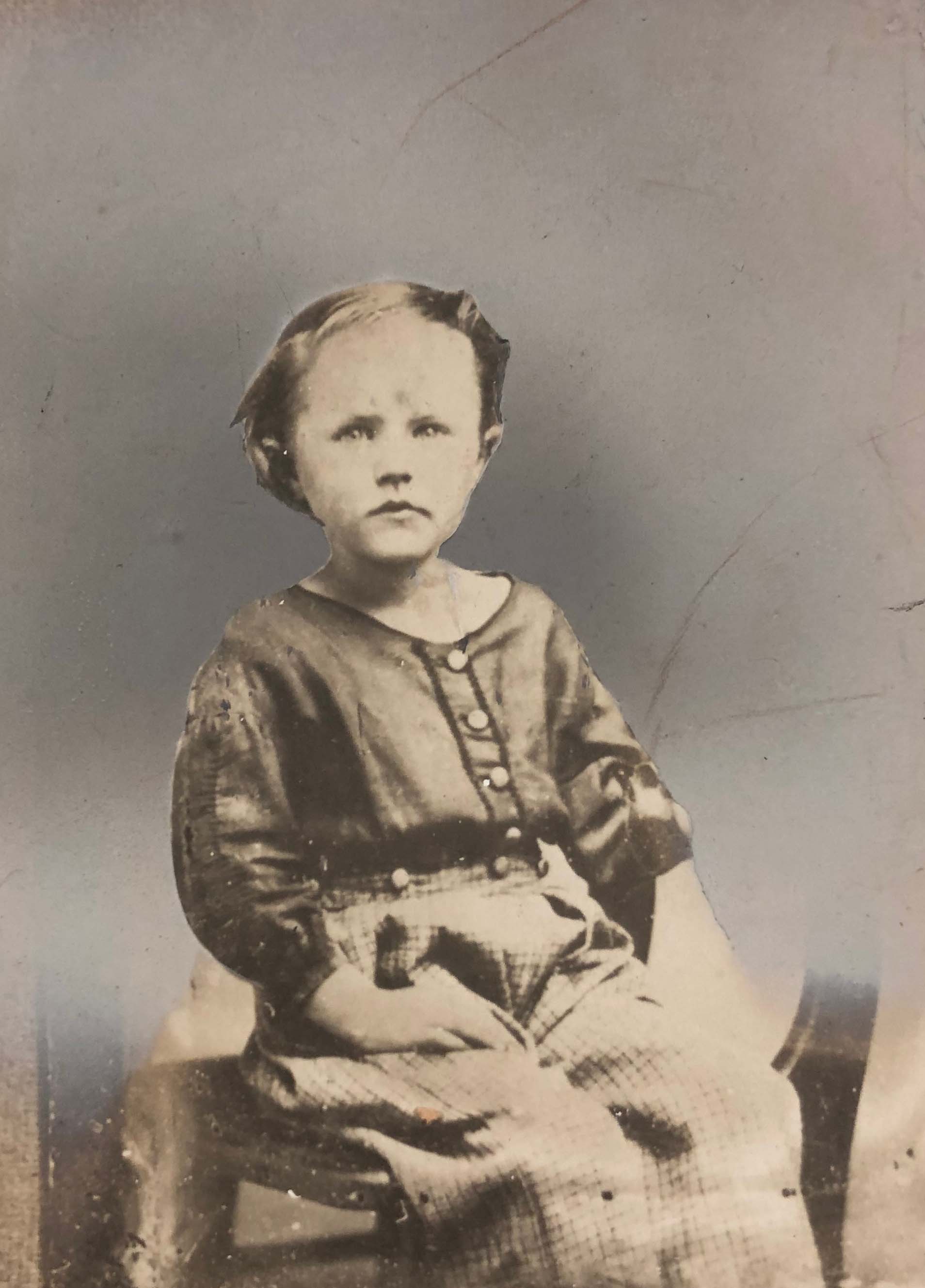 Clark Thomas Richardson, 4 years old. Anderson County Historical
Museum.
Clark Thomas Richardson, 4 years old. Anderson County Historical
Museum.
After Sarah's death, Clark Thomas went to live with his grandparents, Clark Pratt Richardson and Permelia Richardson, in Illinois. His brother, Byron George, went to live with Sarah's sister, Mary Burbank. Both boys took the surnames of the families they lived with, becoming Clark Thomas Richardson and Byron George Burbank. The boys' biological father, Edy Mulcahie, is recorded as living in Missouri soon after Mary's death, so his involvement in the boys' lives was minimal. The boys did not even carry on their father's surname, Mulcahie. Though the boys were not raised together, both Clark Thomas and Byron George became lawyers.
By the 1870 census, a twelve year old Clark Thomas was living with his grandparents, Clark Pratt Richardson and Permelia Richardson (Permelia was Clark Pratt's third wife and not Clark Thomas' biological grandmother), in Illinois. By 1873, grandfather Clark Pratt decided to move the family to Kansas. He loaded up the covered wagon, and they headed west.
Upon arriving in Garnett, Kansas, Clark Pratt bought 80 acres of land just east of the town and proceeded to establish a large farm. The farm had "fifty acres under the plow, and thirty acres in timber land. The fifty acres under cultivation is subdivided into thirty acres of corn, ten in oats, and ten in berries, garden and orchard. In the orchard there are sixty cherry trees, and one hundred peach trees, one hundred raspberry plants, one hundred gooseberry plants, and a half acre of sweet-potatoes, one acre of potatotes." The Richardson farm was profitable. The family sold cherries produced from the farm regularly, but their specialty was the farm's sweet potatos. Clark Pratt often traveled to town to get his potatos weighed, and more often than not, a single potato would weight eight -ten pounds.
Young Clark Thomas spent his first year helping his grandfather on the family farm while attending school in Garnett. In later years, Clark Thomas recalled riding a "diminutive and balky mule" from the farm to school everyday - that is "when the mule was so minded. Every situation has its advantages," said Clark Thomas, "and the idiocyncracies of "Jake" the mule, afforded ample excuse for tardiness, and even absence from school, during its stated hours."
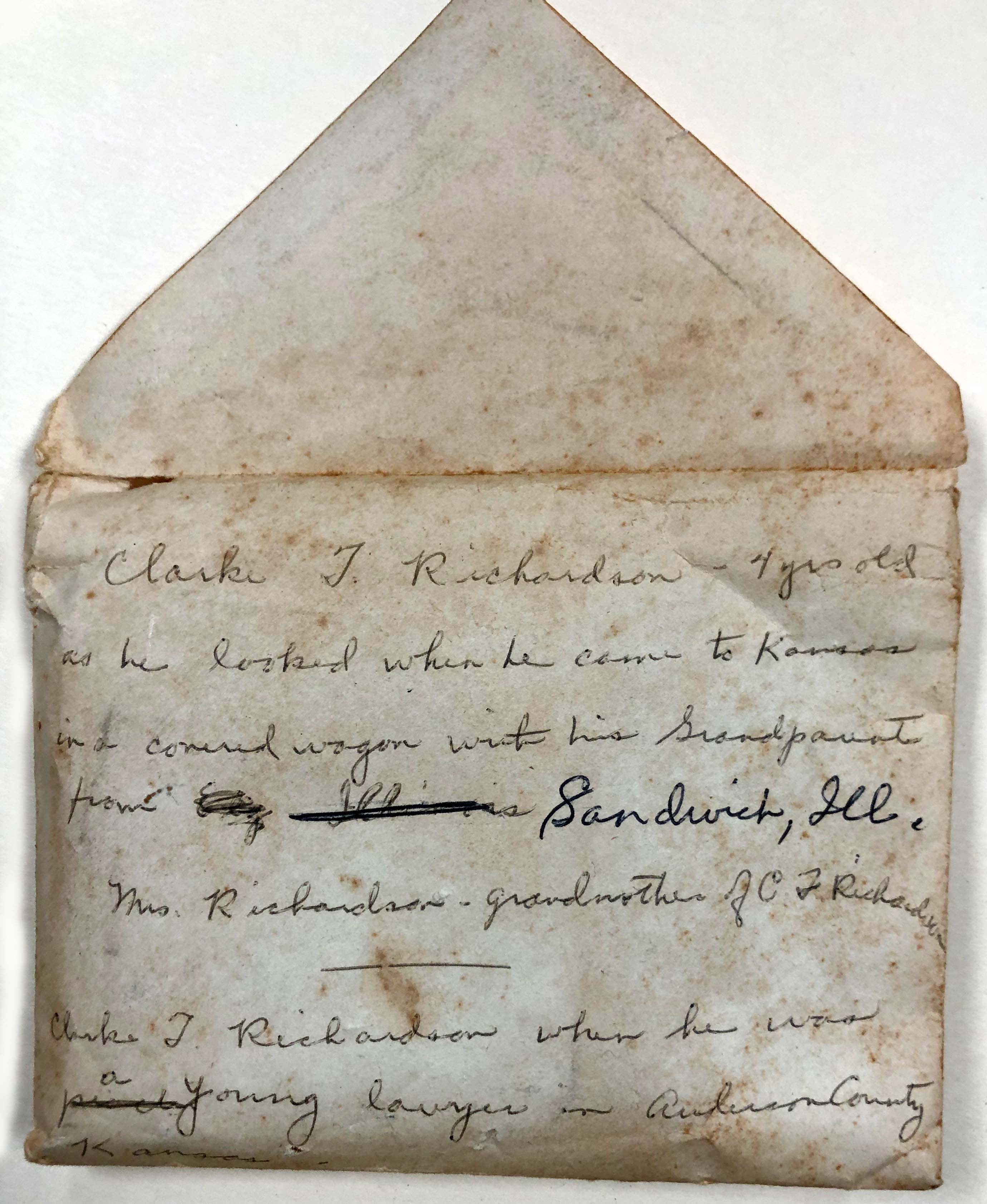 This envelope contains photos of Clark Thomas Richardson,
and his grandmother, Permelia Richardson. Anderson County
Historical Museum Collection.
This envelope contains photos of Clark Thomas Richardson,
and his grandmother, Permelia Richardson. Anderson County
Historical Museum Collection.
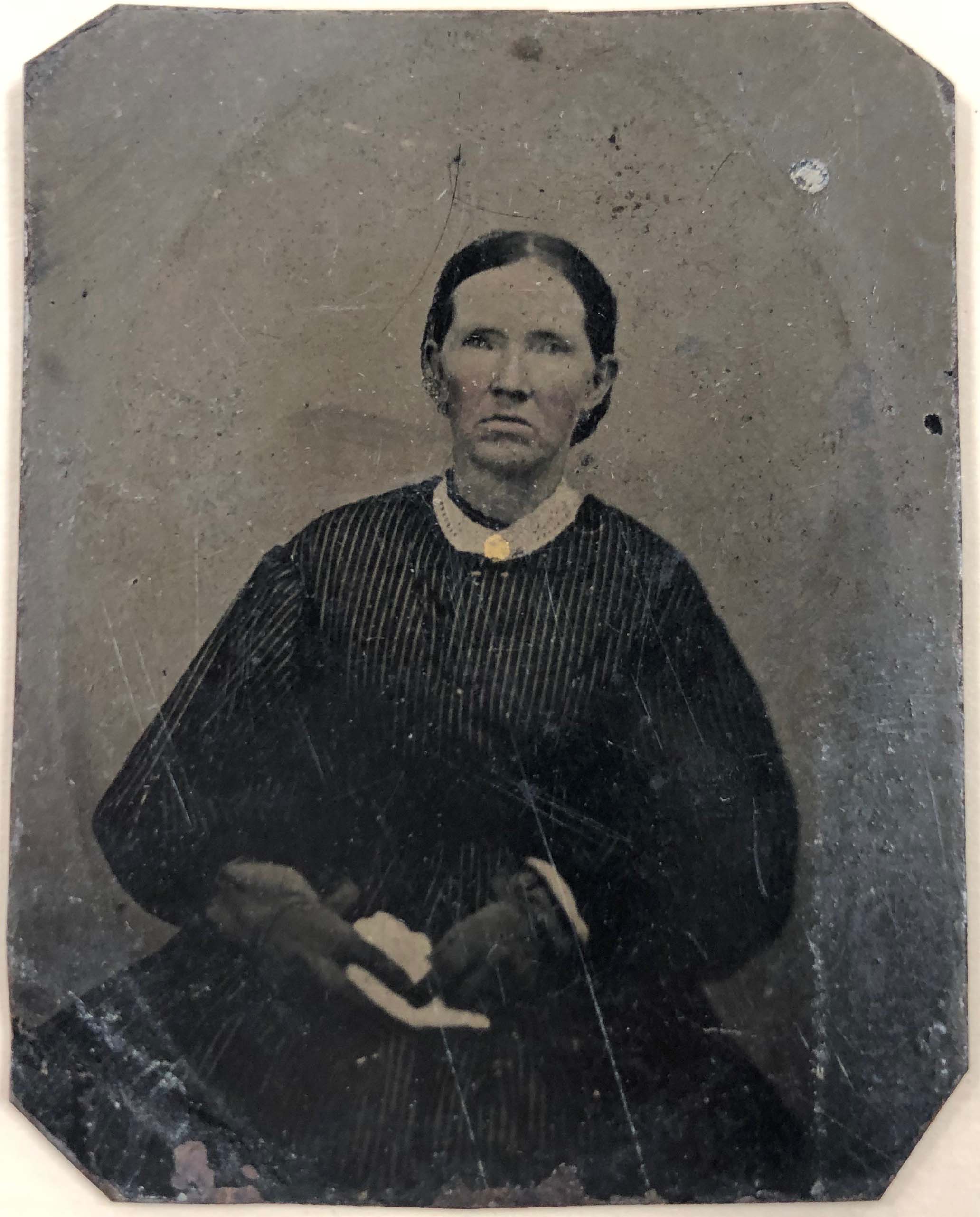 Clark Thomas Richardson's step-grandmother, Permelia (Amelia) Richardson,
wife of Clark Pratt Richardson. Anderson County Historical Museum.
Clark Thomas Richardson's step-grandmother, Permelia (Amelia) Richardson,
wife of Clark Pratt Richardson. Anderson County Historical Museum.
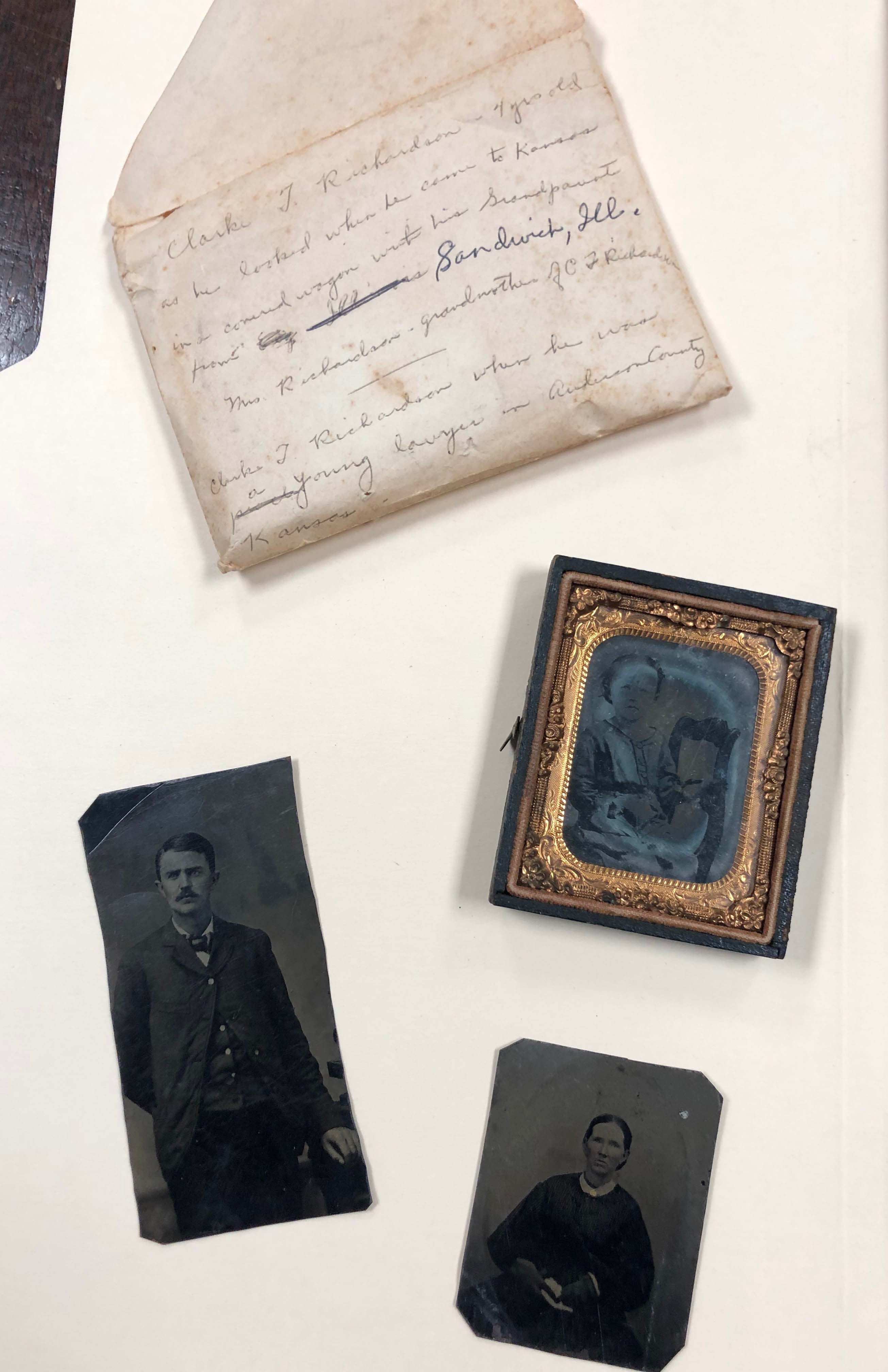 All documents contained in the small envelope. Anderson
County Historical Museum Collection.
All documents contained in the small envelope. Anderson
County Historical Museum Collection.
Clark Thomas attended Garnett High School soon after the family arrived in Garnett. By the spring of 1874, at fifteen years old, Clark Thomas was presented a teaching certificate from the high school. He applied to teach at a nearby school, Bealer, in the summer of 1874, but was denied by the school board because they thought he was too young. He then decided to travel to Colorado where he took a teaching position in a school just north of Denver. After teaching in Colorado for almost two years, he returned to the family farm in Garnett in 1876.
 Clark Thomas Richardson as a young man. Anderson County Historical
Museum Collection.
Clark Thomas Richardson as a young man. Anderson County Historical
Museum Collection.
Clark Thomas' first job as a teacher in Anderson County was a five month assignment at the Kenoma School House in District No. 16. When his first teaching job was complete, he continued to teach at different schools throughout the county, Old Equity, Emerald, Westphalia, Colony, Greely, Lone Elm, as well as schools located in the town of Garnett. He was sometimes referred to as "professor."
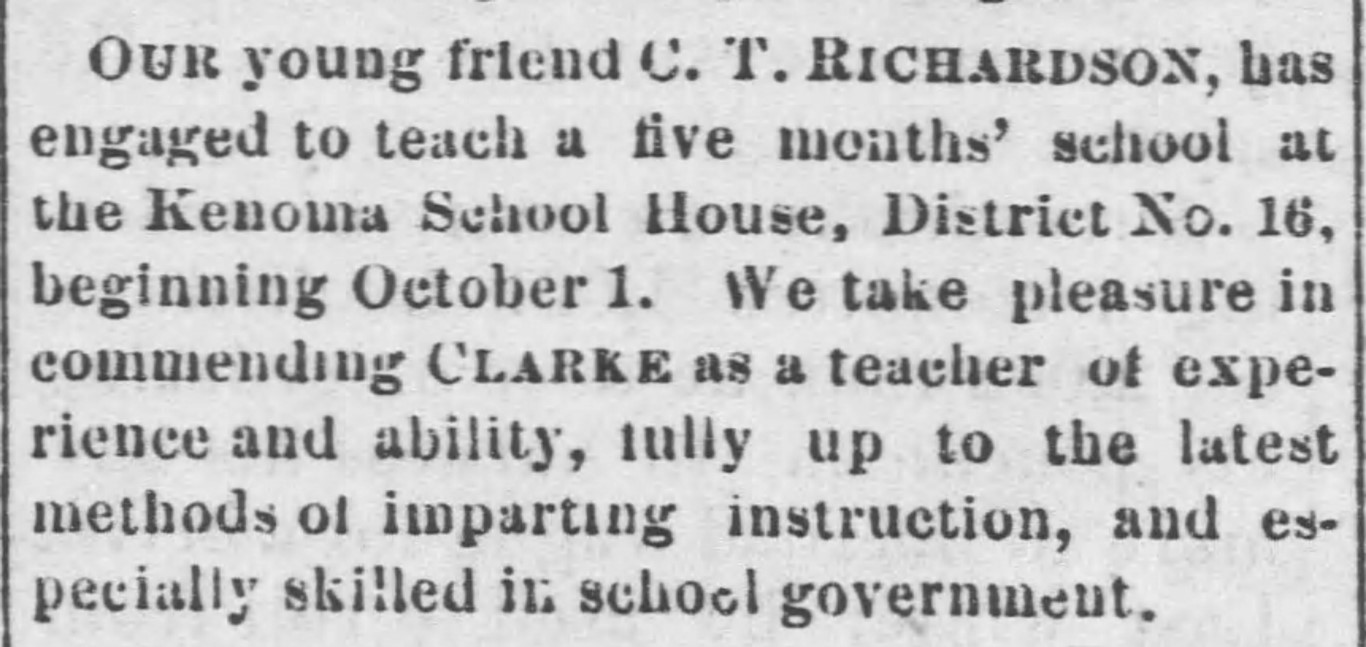 Clark Thomas' first job as teacher in Anderson County. Garnett
Journal, September 1, 1877.
Clark Thomas' first job as teacher in Anderson County. Garnett
Journal, September 1, 1877.
 Clark Thomas, selected as Principal of Greeley school. Garnett
Journal, September 4, 1880.
Clark Thomas, selected as Principal of Greeley school. Garnett
Journal, September 4, 1880.
 Clark Thomas' closes Elm School. Garnett
Journal, March 6, 1891.
Clark Thomas' closes Elm School. Garnett
Journal, March 6, 1891.
 The 1880 Census lists Clark Thomas with his brother, Stephen H. and
his grandfather, Clark Pratt (C.P.) on the family farm. His occupation
is school teacher. Ancestry
full image.
The 1880 Census lists Clark Thomas with his brother, Stephen H. and
his grandfather, Clark Pratt (C.P.) on the family farm. His occupation
is school teacher. Ancestry
full image.
During his term as principal of Greeney school in 1880, Clark Thomas had opportunity to edit his first newspaper, the Greeley Tribune. According to Clark Thomas, the editor of the newspaper left him in charge for two weeks while he (the editor) went on vacation. The editor never came back, so Clark Thomas continued to work the paper after his school day was over. In 1881, the plant was moved to Colony, where Clark Thomas established the first newspaper there, the Free Press.
Clark Thomas' "real" newspaper experience came in 1888 when he began working with Mr. Howard M. Brooke, owner of the Garnett Republican-Plaindealer. Later, he credited Brooke with giving him the most valuable early lessons in the newspaper game.
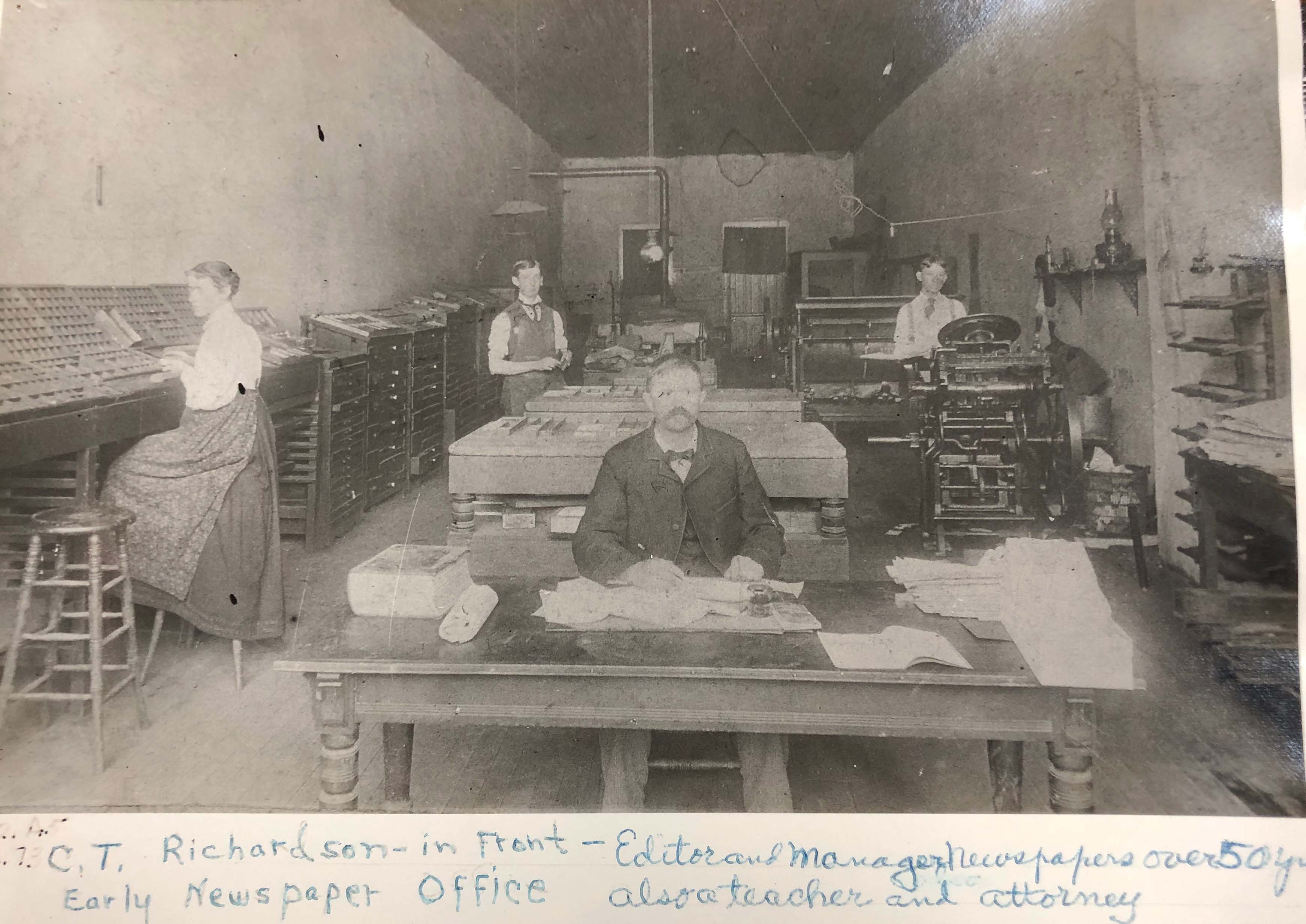 A young Clark Thomas sits at the front desk of a newspaper office
(year unknown). Anderson County Historical Museum Collection.
A young Clark Thomas sits at the front desk of a newspaper office
(year unknown). Anderson County Historical Museum Collection.
Clark Thomas purchased the Garnett Journal in 1895. By this time, he was also serving as Anderson County attorney, and his attorney office was located in the same office as the Garnett Journal.
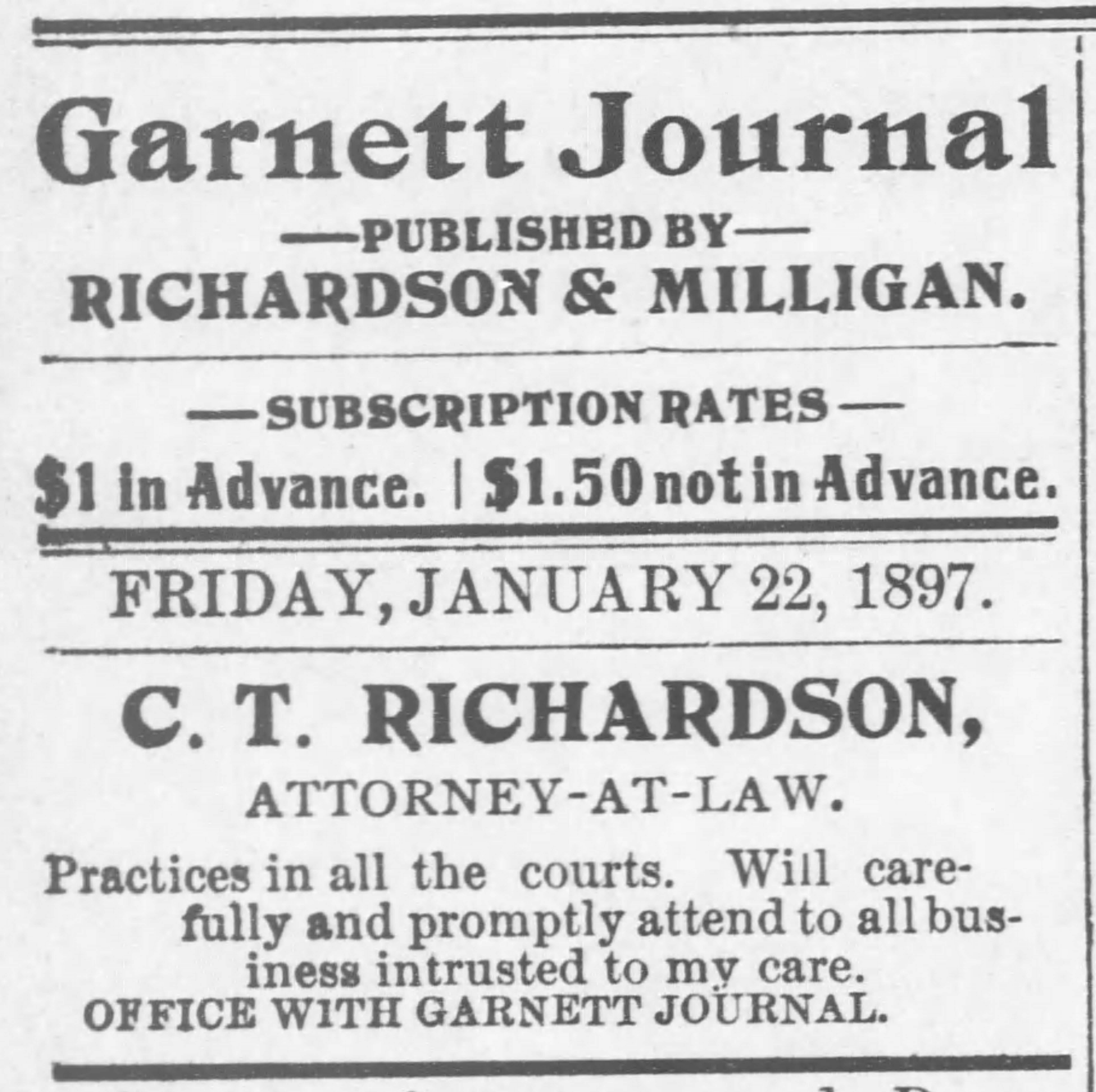 Garnett Journal. August 23, 1895
Garnett Journal. August 23, 1895
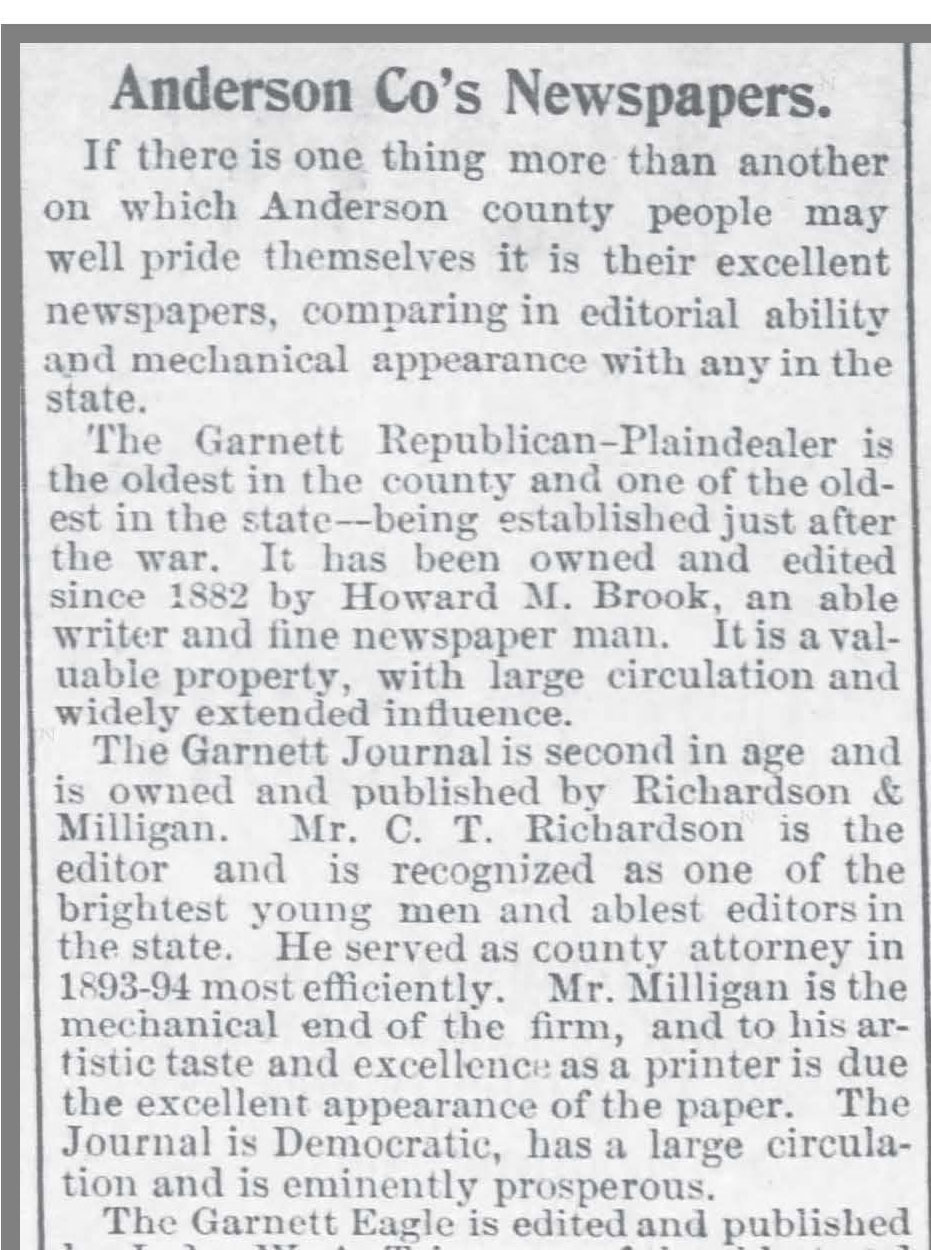 Garnett Journal. August 23, 1895
Garnett Journal. August 23, 1895
After several years as publisher of the Garnett Journal, he sold the paper, however, in 1903, he decided to get involved in the newspaper business again, and purchased the Garnett Eagle- Plaindealer," he sold this paper in 1905. To quote a local newspaper competitor, "Clark Richardson acts like a fish out of water. He said he sold the Journal because he got so tired he didn't know where he was going to stay all night; and now he's hunting around for the change to get back in the newspaper business. Some people never are satisfied, anyhow."
In 1907 Clark Thomas became manager of the Garnett Evening Review with W.O.Champe as editor. The paper was published daily until 1915, then weekly. Champe died in 1929 and Clark Thomas became editor and publisher of The Review and would continue in the role until his death.
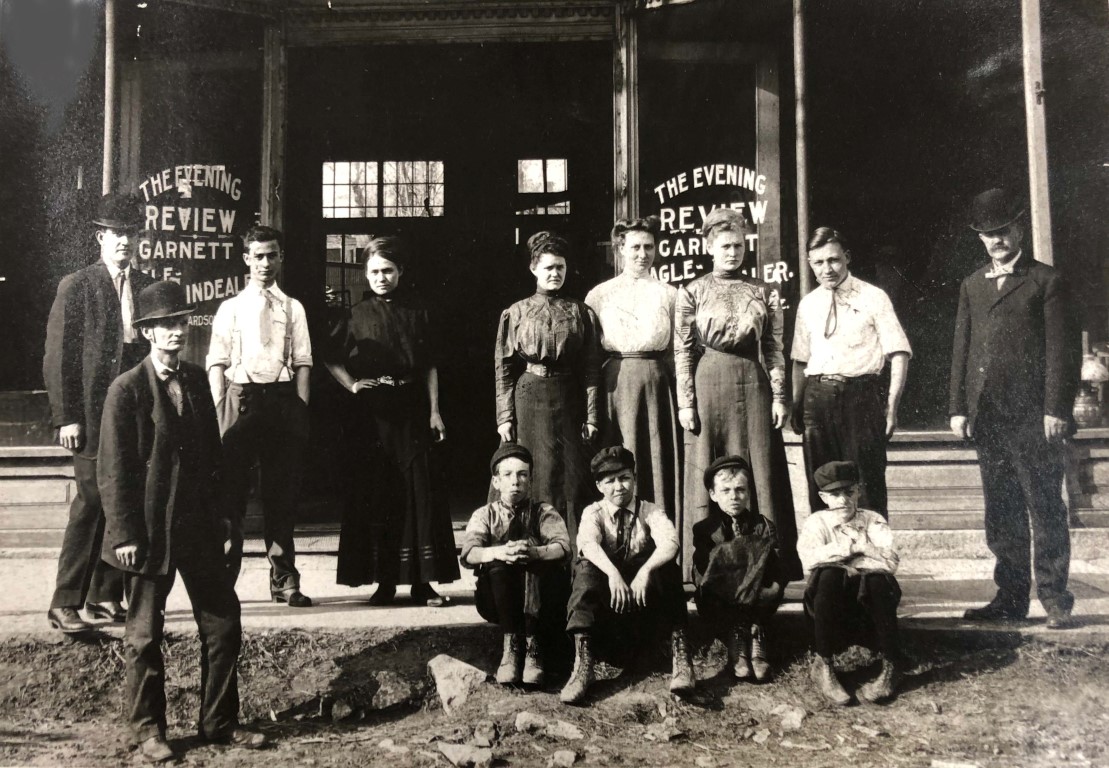 The workforce of the Garnett Evening Review in 1907.
Clark Thomas is on the far right. Anderson County Historical
Museum Collection.
The workforce of the Garnett Evening Review in 1907.
Clark Thomas is on the far right. Anderson County Historical
Museum Collection.
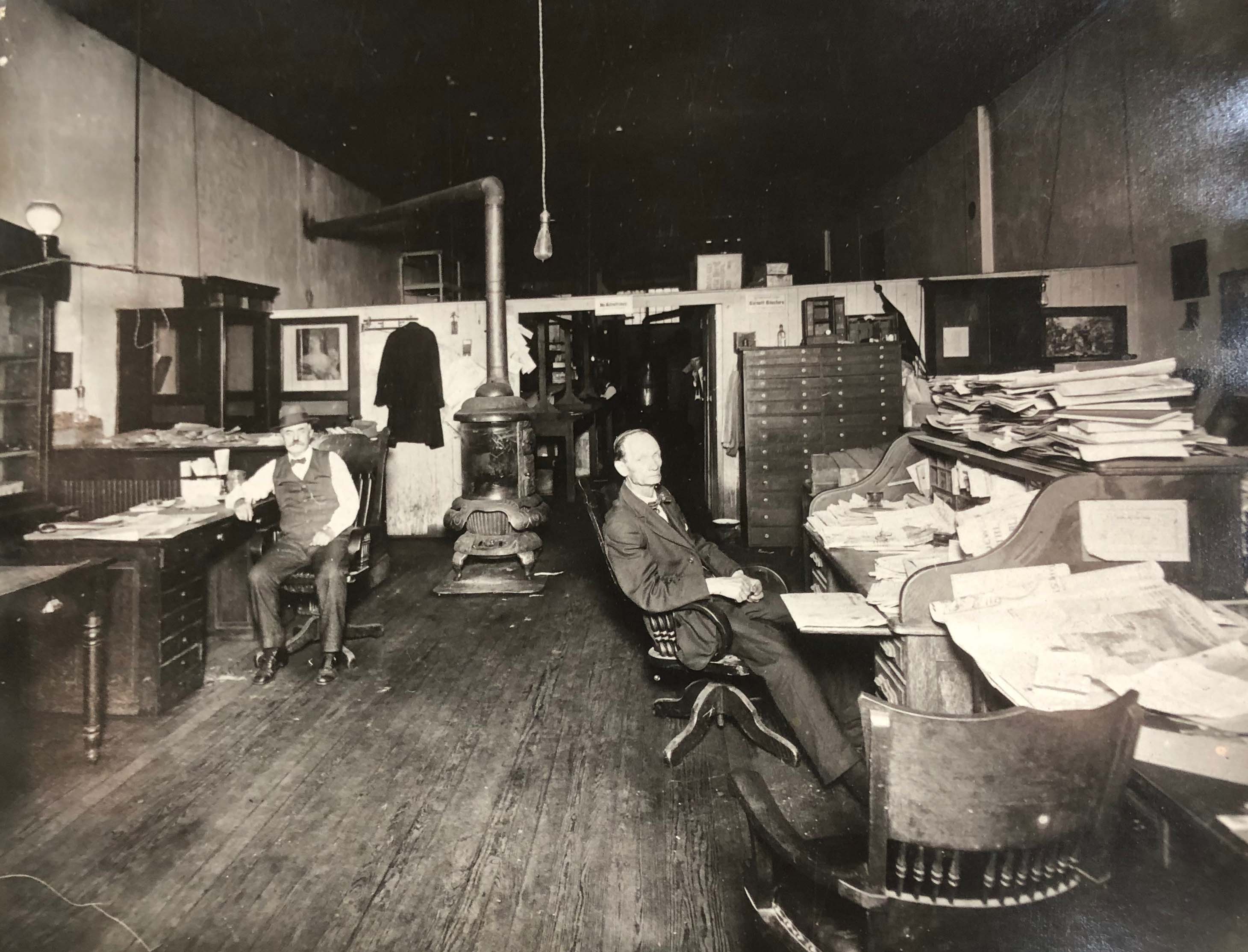 Office of the Garnett Evening Review. Clark Thomas
is on the left. Anderson County Historical Museum Collection.
Office of the Garnett Evening Review. Clark Thomas
is on the left. Anderson County Historical Museum Collection.
As Clark Thomas performed his teaching duties and fulfilled his newspaper editor aspirations, he was also studying to become a lawyer. On September 21, 1889, he was admitted to the bar by the acclamation of a group of attorneys in Garnett. He served as Anderson County attorney for a term in 1889, then moved to Omaha, Nebraska, to work for a time with his brother, Byron G. Burbank, who was established there. By 1892, Clark Thomas returned to Garnett and was re-elected county attorney. He served terms as county and city attorney from 1889-1920.
 Garnett Journal. 1914.
Garnett Journal. 1914.
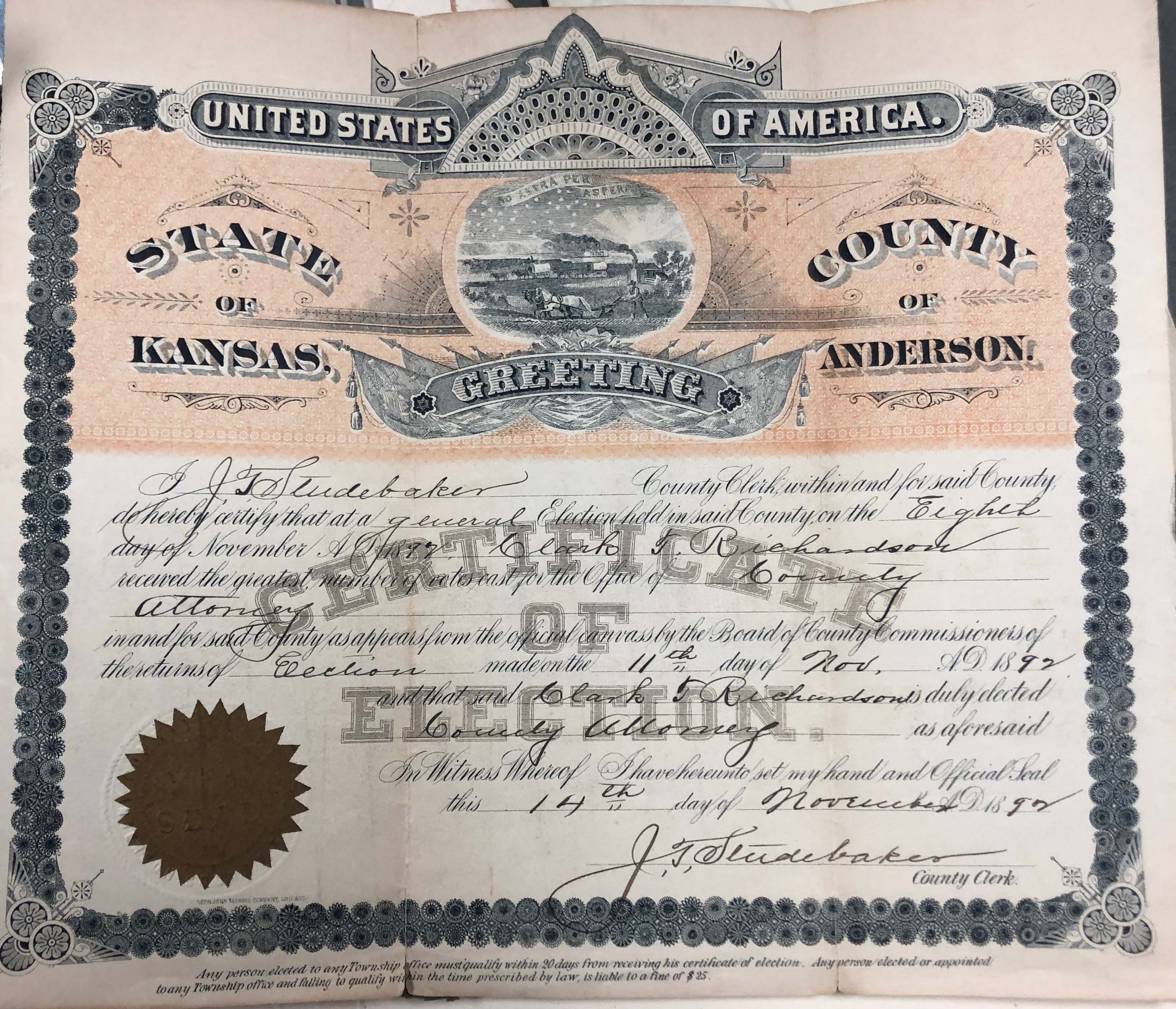 Certificate of Election stating that Clark T. Richardson
received the greatest number of votes cast for the office of attorney
November 11, 1892. Anderson County Historical Museum.
Certificate of Election stating that Clark T. Richardson
received the greatest number of votes cast for the office of attorney
November 11, 1892. Anderson County Historical Museum.
As county attorney, Clark Thomas was called on to provide evidence and briefings in many cases. However, one particular pre-trial examination of local murder suspect, Steve Paul, captured everyone's attention. In 1897, Mrs. Anna Paul was brutally murdered in her home near Garnett. Her nephew, Steve Paul, was arrested for her murder.
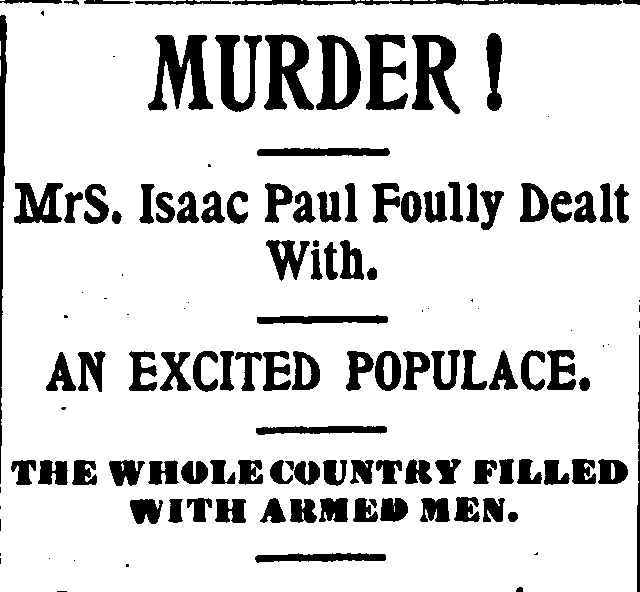 The
Kansas Agitator article from Friday, October 15, 1897.
The
Kansas Agitator article from Friday, October 15, 1897.
Interestingly, Clark Thomas' brother, Stephen H. Richardson, lived close to the murder victim's home where the murder occurred (this is also the home Clark Thomas was raised in when he arrived in Garnett). The murdered woman's husband, Isaac Paul, ran to Stephen H. Richardson's home after the murder and Mrs. Richardson, Stephen's wife, attended to the dying woman.
 The The Garnett Plaindealer and Anderson County Republican
article from October 22, 1897.
The The Garnett Plaindealer and Anderson County Republican
article from October 22, 1897.
After the murder, twenty five witnesses were subpoenaed to appear before the coroner's jury which held its sessions in the sheriff's office behind locked doors. The examination was conducted by Clark Thomas, who was county attorney. Over the course of a few weeks, Clark Thomas gathered evidence and presented his findings at a pre-trial hearing in mid November. The purpose of the hearing was to determine the whereabouts of the accused murderer, Steve Paul, on the day of the murder. It was determined that the suspect was in another county on the day of the murder, so Steve Paul was not held over for trial. The murder was never solved.
Shortly after being elected County Attorney, Clark Thomas moved his office to the ‘new’ building called the Pilkington-Barber block (1892). The building is located on the corner of Oak Street and 5th Avenue, on the west side of Anderson County Courthouse Square.
 The Garnett Republican Plaindealer Friday July 21, 1893.
County Attorney Richardson moves into the second floor
of the Pilkington-Barber building on the corner of Oak Str.
and 5th Ave. on the west side of courthouse square.
The Garnett Republican Plaindealer Friday July 21, 1893.
County Attorney Richardson moves into the second floor
of the Pilkington-Barber building on the corner of Oak Str.
and 5th Ave. on the west side of courthouse square.
 A photo of the Pilkington-Barber building on
the west side of courthouse square in Garnett (1895-1900). County
Attorney Clark Thomas Richardson's moved his office on the
second floor of this corner building in 1893.
A photo of the Pilkington-Barber building on
the west side of courthouse square in Garnett (1895-1900). County
Attorney Clark Thomas Richardson's moved his office on the
second floor of this corner building in 1893.
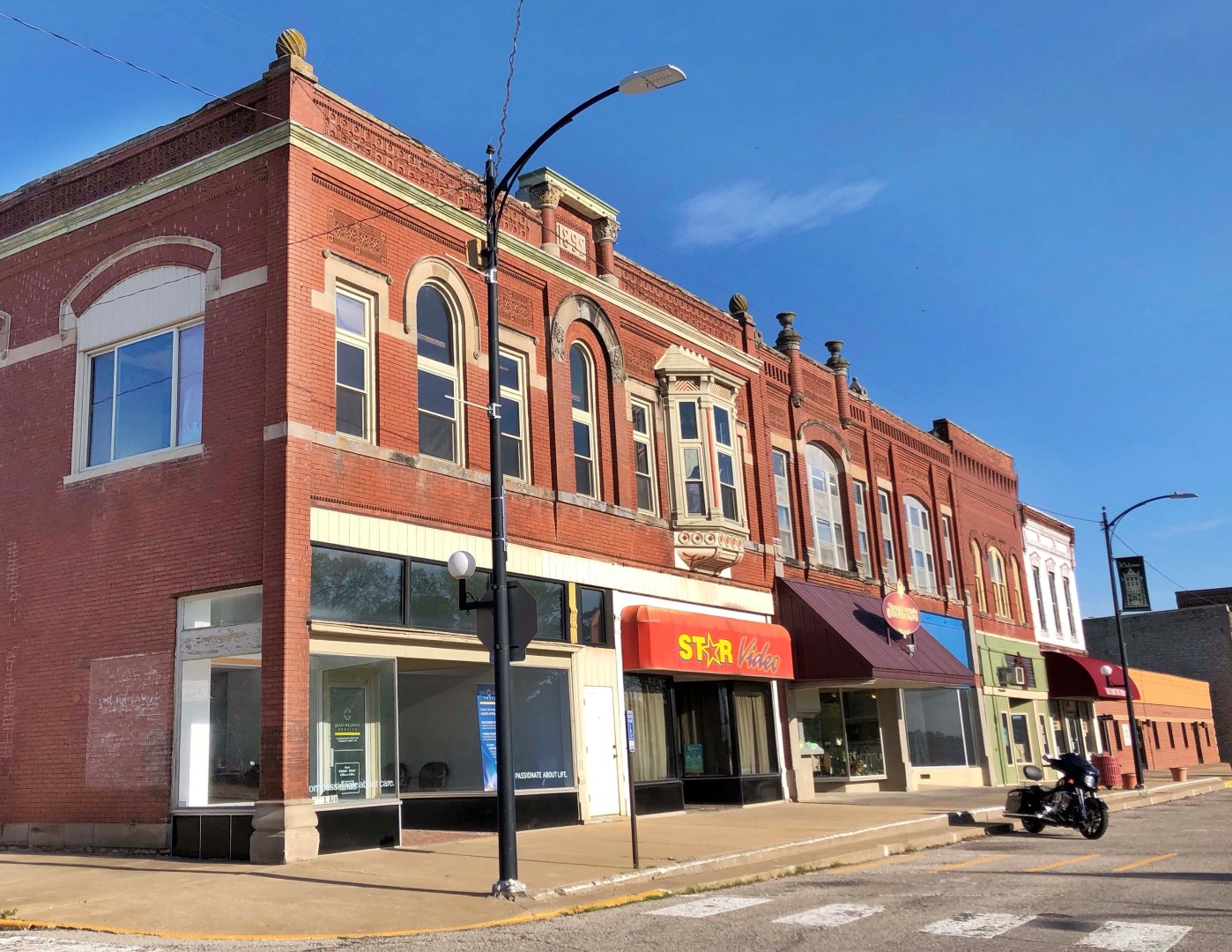 A 2019 photo of the Pilkington-Barber building on
the west side of courthouse square in Garnett. County
Attorney Clark Thomas Richardson moved his office on the
second floor of this corner building in 1893. P Marlin
A 2019 photo of the Pilkington-Barber building on
the west side of courthouse square in Garnett. County
Attorney Clark Thomas Richardson moved his office on the
second floor of this corner building in 1893. P Marlin
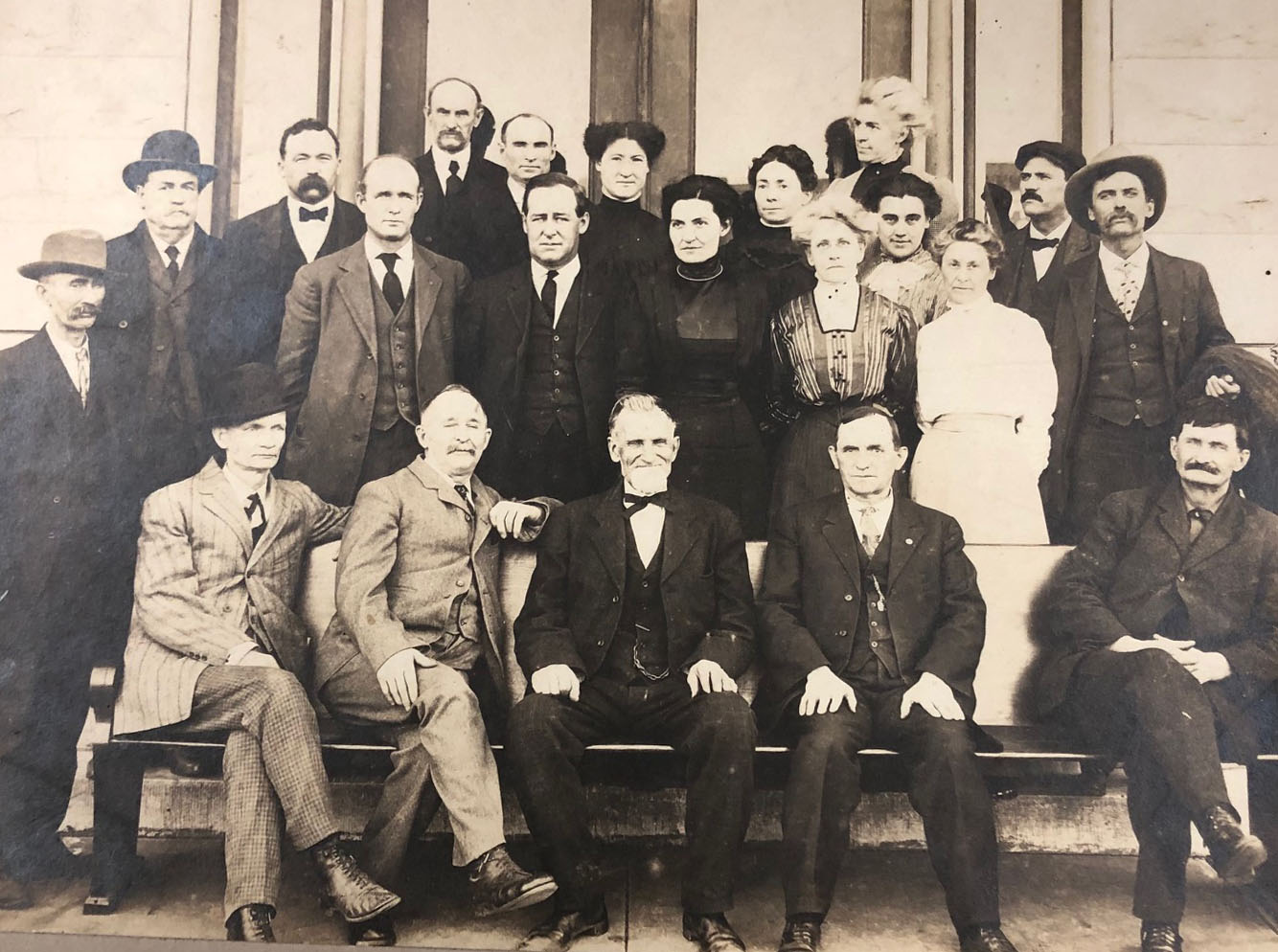 Anderson County Courthouse (Garnett) employees. Clark Thomas is standing, with
hat on, second from left. Anderson County Historical Museum.
Anderson County Courthouse (Garnett) employees. Clark Thomas is standing, with
hat on, second from left. Anderson County Historical Museum.
In 1895, Clark Thomas represented Anderson County on four Kansas banks' tax cases that were presented to the Kansas Supreme Court. These cases were in regards to the collection of certain taxes for the years 1890, 91, 92, and 93. The banks involved were the Bank of Garnett, Bank of Greeley, Bank of Colony and Bank of Westphalia vs J.W. Farris, the Board of County Commissioners, and Treasurer of Anderson County. The cases were argued at the December term of the Supreme Court with Clark Thomas submitting arguments and briefs for both sides.
 Certificate stating that Clark Thomas is duly admitted to practice
in the Kansas Supreme Court. Anderson County Historical Museum.
Certificate stating that Clark Thomas is duly admitted to practice
in the Kansas Supreme Court. Anderson County Historical Museum.
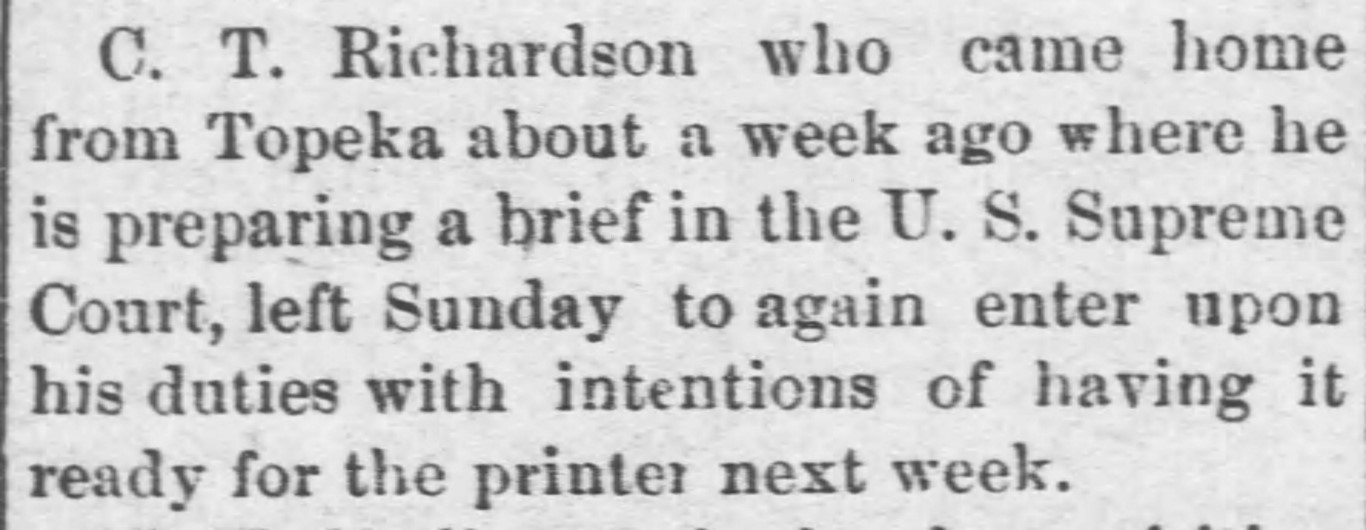 Garnett Journal. December 13, 1895
Garnett Journal. December 13, 1895
As a lawyer and newswpaper man, Clark Thomas was interested in politics of local and state-wide government and was active in the local representation of the Greenback Party. Clark Thomas was vocal in his opinion of local and national politics. He even changed political parties at one point, which was written about in the following article.
 Garnett Journal, May 22, 1891.
Garnett Journal, May 22, 1891.
 Garnett Journal, May 22, 1891.
Garnett Journal, May 22, 1891.
In 1888 Clark Thomas married Emma Woods in Garnett. No children were born to this union. Clark Thomas and Emma lived in many locations during their early marriage, by 1920, however, they lived at 230 W 5th Avenue in Garnett until Clark Thomas' death.
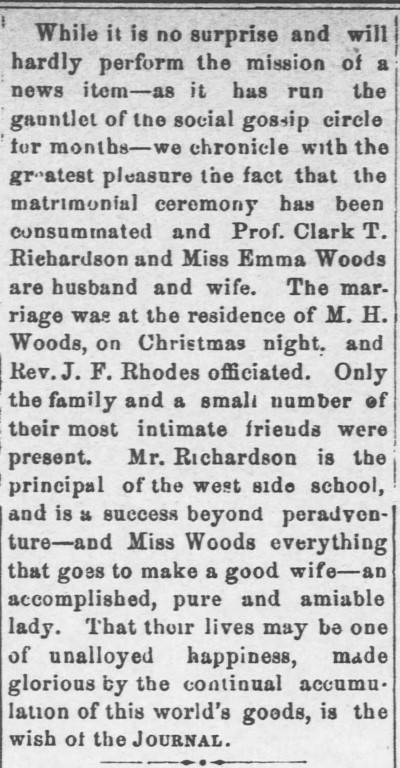 Garnett Journal, December 28, 1888.
Garnett Journal, December 28, 1888.
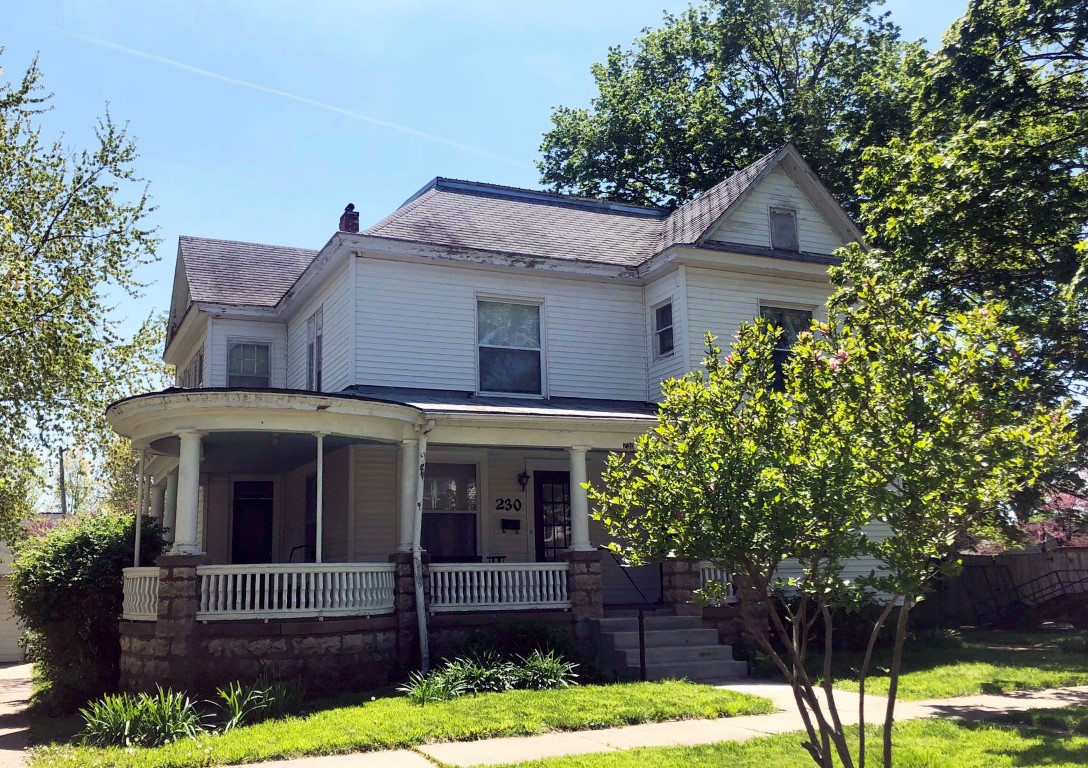 Clark Thomas' house at 230 W 5th Avenue in Garnett, Kansas.
P. Marlin
Clark Thomas' house at 230 W 5th Avenue in Garnett, Kansas.
P. Marlin
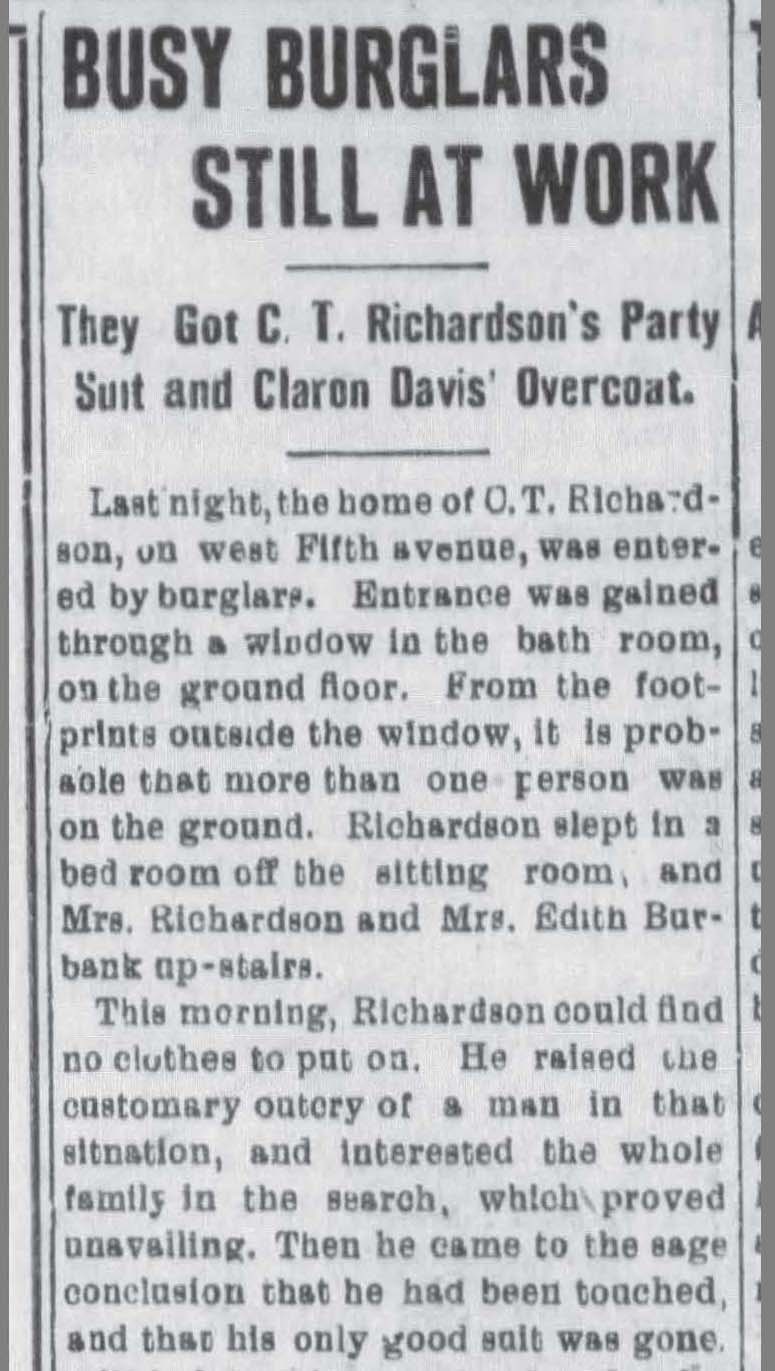 Clark Thomas' house burglary as reported by The Evening
Review on January 27, 1914.
Full article
Clark Thomas' house burglary as reported by The Evening
Review on January 27, 1914.
Full article
After Clark Thomas' death on March 14, 1932, the Colony Free Press, a paper he once edited, wrote an article entitled, "His Good Work Will Live After Him" to which the following is taken.
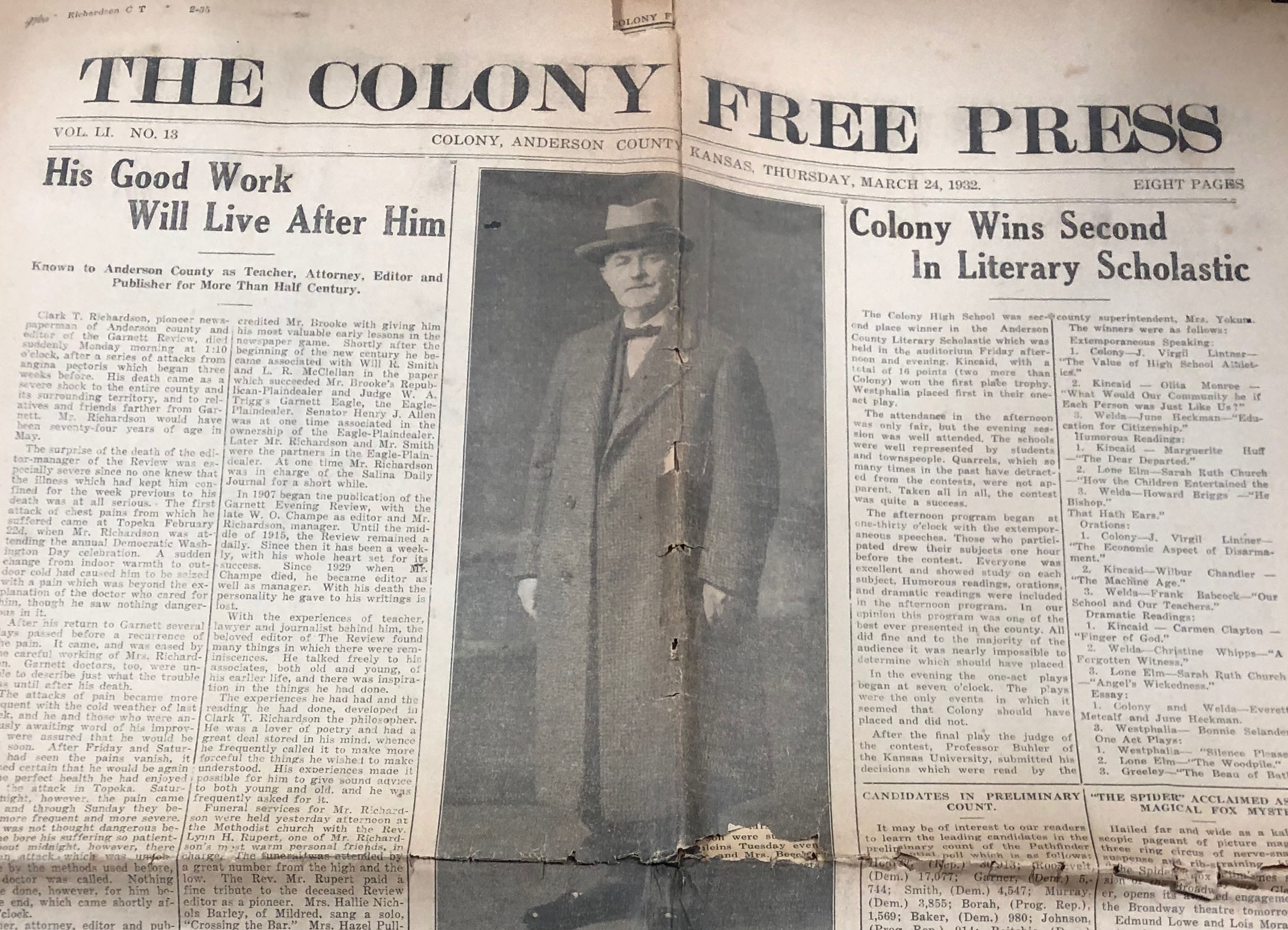 An article on Clark Thomas Richardson in the Colony
Free Press after his death entitled, "His Good Work Will Live After Him."
March 24, 1932. Anderson County Historical Museum.
An article on Clark Thomas Richardson in the Colony
Free Press after his death entitled, "His Good Work Will Live After Him."
March 24, 1932. Anderson County Historical Museum.
"The surprise death of the editor-manager of the Review was especially severe since no one knew that the illness which had kept him confined for the week previous to his death was at all serious. The first attack of chest pains from which he suffered came at Topeka February 22, when Mr. Richardson was attending the annual Democratic Washington Day celebration. After his return to Garnett several days passed before a recurrence of the pain. It came, and was eased by the careful working of Mrs. Richardson. Garnett doctors, too, were unable to describe just what the trouble was until after his death."
"With the experiences of teacher, lawyer, and journalist behind him, the beloved editor of The Review found many things in which there were reminiscences. He talked freely to his associates, both old and young, of his earlier life, and there was inspiration in the things he had done. The experiences he had had and the reading he had done, developed in Clark T. Richardson the philosopher. He was a lover of poetry and had a great deal stored in his mind, whence he frequently called it to make more forceful the things he wished to make understood. His experiences made it possible for him to give sound advice to both young and old. and he was frequently asked for it."
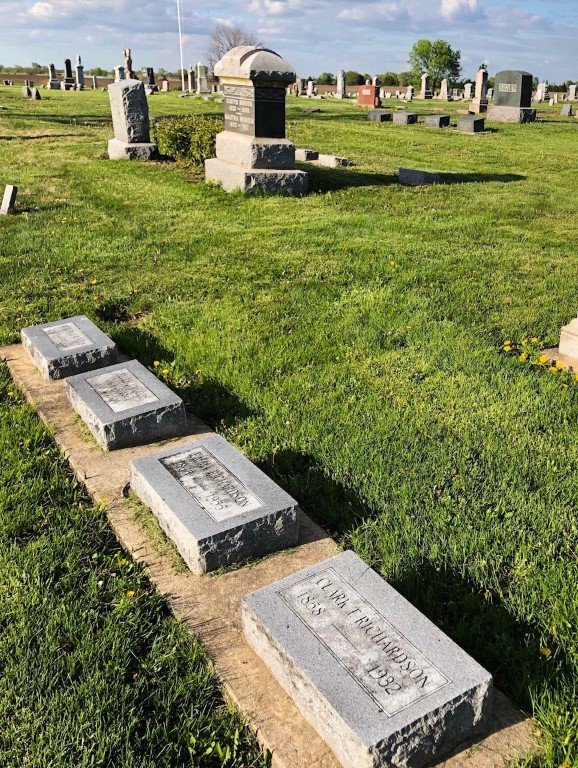 Burial site of Clark Thomas and his wife, Emma, at the Garnett
Cemetery. P Marlin
Burial site of Clark Thomas and his wife, Emma, at the Garnett
Cemetery. P Marlin
 Clark Thomas death record.
Clark Thomas death record.
In 1921, a farmhouse owned by the Skeens family, just east of Garnett, was lost due to fire. The writer of the article, Clark Thomas, remembered the old farmhouse well. "The house burned was built by [my grandfather] Clark Pratt Richardson in the winter of 1873-74 on eighty acres, which was afterward combined with the eighty east of it, and both owned by Stephen H. Richardson. The writer of this, Clark Richardson, spent his first winter in Kansas in this house, and near-by Kansas stable - rock walls and hay roof - sheltered in the still-remembered diminutive and bulky mule he rode to the Garnett High School - that is he rode when the mule was "so minded" ..."